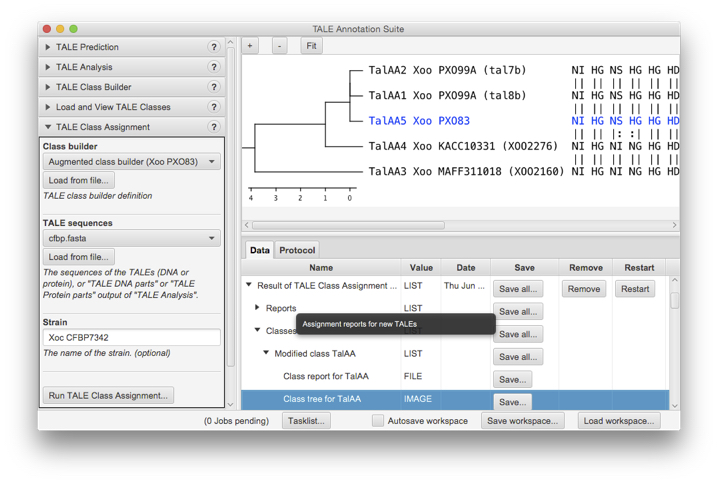AnnoTALE: Difference between revisions
| Line 34: | Line 34: | ||
''AnnoTALE is distributed in the hope that it will be useful, but without any warranty; without even the implied warranty of merchantability or fitness for a particular purpose.'' | ''AnnoTALE is distributed in the hope that it will be useful, but without any warranty; without even the implied warranty of merchantability or fitness for a particular purpose.'' | ||
* [http://www.jstacs.de/downloads/AnnoTALE-1. | * [http://www.jstacs.de/downloads/AnnoTALE-1.2.jar Runnable Jar] (requires Java 8, update 45 or greater) | ||
* Mac-DMG of AnnoTALE including Java: [http://www.jstacs.de/downloads/AnnoTALE-1. | * Mac-DMG of AnnoTALE including Java: [http://www.jstacs.de/downloads/AnnoTALE-1.2-2GB.dmg 2GB version], [http://www.jstacs.de/downloads/AnnoTALE-1.2-6GB.dmg 6GB version] | ||
* Windows installer of AnnoTALE including Java: [http://www.jstacs.de/downloads/AnnoTALE-1. | * Windows installer of AnnoTALE including Java: [http://www.jstacs.de/downloads/AnnoTALE-1.2-2GB.exe 2GB version, 64bit Java], [http://www.jstacs.de/downloads/AnnoTALE-1.2-6GB.exe 6GB version, 64bit Java]; in addition, we provide a [http://www.jstacs.de/downloads/AnnoTALE-1.2-1GB.exe 1GB version with 32bit Java] for earlier and 32bit versions of Windows. Please use this version only if absolutely necessary, as some tools may not work due to memory restrictions. | ||
=== User Guide === | === User Guide === | ||
Revision as of 19:30, 10 April 2017
Transcription activator-like effectors (TALEs) are virulence factors of plant-pathogenic Xanthomonas spp. that function as gene activators inside plant host cells.
AnnoTALE is a suite of applications for identifying and analysing TALEs in Xanthomonas genomes, for clustering TALEs into classes by their RVD sequences, for assigning novel TALEs to existing classes, for proposing TALE names using a unified nomenclature, and for predicting targets of individual TALEs and TALE classes.
AnnoTALE is available as a JavaFX-based stand-alone application with graphical user interface for interactive analysis sessions. In addition, we provide a command line application that may be integrated into other pipelines. Both use identical code for the actual analysis, ensuring consistent results between both versions.
If you use AnnoTALE, please cite:
Jan Grau, Maik Reschke, Annett Erkes, Jana Streubel, Richard D. Morgan, Geoffrey G. Wilson, Ralf Koebnik and Jens Boch. AnnoTALE: bioinformatics tools for identification, annotation, and nomenclature of TALEs from Xanthomonas genomic sequences. Scientific Reports 6:21077, DOI: 10.1038/srep21077, 2016.
Important: If you would like to use the unified nomenclature of AnnoTALE in one of your publications including new TALEs or sequenced genomes, please contact us (grau@informatik.uni-halle.de) to organize the inclusion of your TALEs into the official class definition of AnnoTALE and to create stable TALE names that are unique to your TALEs.
AnnoTALE with GUI
AnnoTALE is based on the very recent implementation of JavaFX in Java 8.
We provide AnnoTALE as a runnable JAR file for those with a current version of Java 8 (at least update 45) on their machine.
For user's convenience, we also provide pre-packaged versions of AnnoTALE, which also include Java in the required version, for Mac OS X and Windows. Each of these versions is available two version with different memory requirements (2GB and 6GB). As long as the main memory (RAM) of your machine is sufficient, we recommend to use the 6GB version of AnnoTALE.
Download
AnnoTALE is distributed in the hope that it will be useful, but without any warranty; without even the implied warranty of merchantability or fitness for a particular purpose.
- Runnable Jar (requires Java 8, update 45 or greater)
- Mac-DMG of AnnoTALE including Java: 2GB version, 6GB version
- Windows installer of AnnoTALE including Java: 2GB version, 64bit Java, 6GB version, 64bit Java; in addition, we provide a 1GB version with 32bit Java for earlier and 32bit versions of Windows. Please use this version only if absolutely necessary, as some tools may not work due to memory restrictions.
User Guide
We provide an AnnoTALE User Guide in PDF format, including a detailed description of all AnnoTALE tools and installation instructions.
AnnoTALE command line application
The AnnoTALE command line application is available as a runnable Jar. For running the program and a quick help, type
java -jar AnnoTALEcli-1.2.jar
For larger analyes, it might be necessary to increase the memory allocated by the JavaVM using the -Xms and -Xmx parameters, for instance
java -Xms512M -Xmx6G -jar AnnoTALEcli-1.2.jar
There is no separate User Guide for the AnnoTALE command line application, but the User Guide for the GUI version describes all AnnoTALE tools, their parameters and outputs, and those of the CLI version are identical.
You obtain a list of all AnnoTALE tools by calling
java -jar AnnoTALEcli-1.2.jar
Output:
Available tools: predict - TALE Prediction
analyze - TALE Analysis build - TALE Class Builder loadAndView - Load and View TALE Classes assign - TALE Class Assignment rename - Rename TALEs in File targets - Predict and Intersect Targets presence - TALE Class Presence repdiff - TALE Repeat Differences
Syntax: java -jar AnnoTALEcli-1.2.jar <toolname> [<parameter=value> ...] Further info about the tools is given with java -jar AnnoTALEcli-1.2.jar <toolname> info Tool parameters are listed with java -jar AnnoTALEcli-1.2.jar <toolname>
You get a list of input parameters by calling AnnoTALEcli-1.2.jar with the corresponding tool name, e.g.,
java -jar AnnoTALEcli-1.2.jar predict
Output:
At least one parameter has not been set (correctly): Parameters of tool "TALE Prediction" (predict): g - Genome (The input Xanthomonas genome in FastA or Genbank format) = null s - Strain (The name of the strain, will be used for annotated TALEs, OPTIONAL) = null outdir - The output directory, defaults to the current working directory (.) = .
You get a description of each tool by calling AnnoTALEcli-1.0.jar with the corresponding tool name and keyword "info", e.g.,
java -jar AnnoTALEcli-1.2.jar predict info
Output:
A detailed description of all tools is available in the AnnoTALE User Guide (http://www.jstacs.de/downloads/AnnoTALE-UserGuide-1.0.pdf).
*TALE Prediction* predicts transcription activator-like effector (TALE) genes in an input sequence, typically a 'Xanthomonas' genome. 'TALE Prediction' is based in HMMer nucleotide HMM models that describe N-terminus, repeat region, and C-terminus of TALEs. The input 'Genome' may be provided in FastA or Genbank format. Optionally, you may provide a strain name that will be used in the temporary TALE names and names of output files. Regardless of the input format, 'TALE Prediction' generates output in Genbank format containing the annotations of TALE genes. If the original input has already been a Genbank file, TALE annotations are added to the existing ones. In addition, 'TALE Prediction' generates annotations in GFF format, and also outputs the DNA and AS sequences of the predicted TALEs in FastA format. 'TALE Prediction' tries hard to make the CDS annotation a proper gene model, starting from a start codon and ending with a Stop. If either start or stop codon are located within the originally predicted region that is homologous to TALE genes, this original hit region is still reported as mRNA. Putative pseudo genes, e.g., with premature stop codons, are marked accordingly. The TALE DNA sequences output of 'TALE Prediction' may serve as input of the 'TALE Analysis', 'TALE Class Builder', and 'TALE Class Assignment' tools. If you experience problems using 'TALE Prediction', please contact us.
Standard pipeline
Assuming that your current working directory contains the AnnoTALEcli Jar file, a genome of interest (of a hypothetical 'Xoo' strain PXO999 with accesion CP1234567) in a FastA file "genome.fa", all rice promoters in a FastA file "Rice-promoters.fa", and a directory "out" designated to hold all output files, a typical AnnoTALE pipeline could look like
java -jar AnnoTALEcli-1.2.jar predict g=genome.fa outdir=out java -jar AnnoTALEcli-1.2.jar analyze t=out/TALE_DNA_sequences.fasta outdir=out java -jar AnnoTALEcli-1.2.jar loadAndView outdir=out java -jar AnnoTALEcli-1.2.jar assign c=out/Class_builder_download.xml t=out/TALE_DNA_parts.fasta s="Xoo PXO999" a="CP1234567" outdir=out java -jar AnnoTALEcli-1.2.jar rename r=out/TALE_names_\(Xoo_PXO999\).tsv i=out/Genbank__TALE_predictions.gb outdir=out java -jar AnnoTALEcli-1.2.jar targets i=Rice-promoters.fa p="TALEs in class builder" c=out/Augmented_class_builder_\(Xoo_PXO999\).xml outdir=out
Afterwards, you find all output files of all those tools in the directory "out". The output files and directories are named in analogy to the names in the AnnoTALE GUI version (see User Guide for the GUI version)
Version history
AnnoTALE
Version 1.2:
- Results and loaded files may now be renamed in the GUI by clicking on the corresponding name in the "Data" panel
- Minor bugfixes and improvements of the GUI (Protocol may be erased, columns in "Data" panel renamed for clarity, consistency of paths in the open/save dialogs under Linux)
- Two new tools: "TALE Class Presence" and "TALE Repeat differences"
Version 1.1:
- AnnoTALE 1.1 Runnable Jar (requires Java 8, update 45 or greater)
- Mac-DMG of AnnoTALE 1.1 including Java: AnnoTALE 1.1 2GB version, AnnoTALE 1.1 6GB version
- Windows installer of AnnoTALE 1.1 including Java: AnnoTALE 1.1 2GB version, 64bit Java, AnnoTALE 1.1 6GB version, 64bit Java; AnnoTALE 1.1 1GB version with 32bit Java
- AnnoTALE 1.1 command line application
Changes:
- Additional output for the "Load and View TALE Classes" tool
- "TALE Class Builder" and "TALE Class Assignment" now also accept RVD sequences (separated by dashes) as input. However, this is not recommended and some features (e.g., highlighting of aberrant repeats) will not be available. Only complete TALE DNA sequences will be accepted for inclusion into the official Class Builder.
- The internal help pages now link to the PDF User Guide
Version 1.0:
Initial AnnoTALE release
- AnnoTALE 1.0 Runnable Jar (requires Java 8, update 45 or greater)
- Mac-DMG of AnnoTALE including Java: AnnoTALE 1.0 2GB version, AnnoTALE 1.0 6GB version
- Windows installer of AnnoTALE including Java: AnnoTALE 1.0 2GB version, 64bit Java, AnnoTALE 1.0 6GB version, 64bit Java; AnnoTALE 1.0 1GB version with 32bit Java
- AnnoTALE 1.0 command line application
Class Builders
- Current version: used for "Download current definition" in "Load and View TALE Classes" within AnnoTALE
- Version 03/11/2016
- Version 01/29/2016
- Version 10/19/2015: used in the AnnoTALE publication (Grau et al., Sci Rep, 2016)

